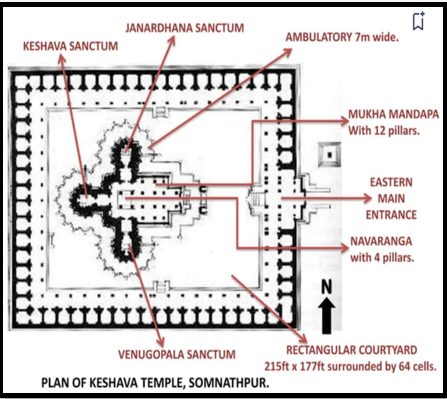Context:
The Karnataka government plans to develop Somanathapur as part of Mysuru tourism circuit.
More on the News

- The Tourism Department in Karnataka has plans to promote the UNESCO World Heritage Site of Somanathapur as part of the Mysuru tourism circuit in a big way before Dasara this year.
- This will be done through cross-promotion of the 13th-century heritage site of the Keshava temple at popular places of tourist interest like the palace, zoo or the Chamundi Hills so that visitors can get an idea of the temple and plan a visit.
Cross-promotion involves putting up an information board about the Keshava temple built by the Hoysalas, at places frequented by tourists in Mysuru so that they become aware of it. - Apart from cross-promotion the Tourism Department will also discuss the feasibility of operating buses to ferry tourists to Somanathapur.
Keshava Temple, Somanathapura – History

- The Keshava Temple at Somanathapura, also known as Chennakeshava Temple is dedicated to Lord Vishnu and was constructed by a commander of the Hoysala Army, Somanatha.
- The construction of the temple was completed and consecrated in 1268 AD.
Keshava Temple, Somanathapura – Architecture
- It is a typical example of the fully evolved Hoysala style architecture in the 13th century Kesava temple at Somanathpur, 40 km from Mysore city.
- The main temple stands at the center of a courtyard on a high star-shaped platform with three symmetrical sanctums, or garbha-griha on the west, South and North to Keshava, Venugopala and Janardhana, all connected.
- The temple itself occupies the middle of the rectangular courtyard surrounded by 64 cells each with pillars in front.
- It is a triple shrine structure contained within a rectangular courtyard.
- It contains southern-style gopuras, which are vimana-like in form, the profusion of pillars in the entranceway suggests the form of a Hoysala mandapa.
- The temple consists of three vimanas, each having an antechamber and shrine, with a single, shared mandapa, which is preceded by a smaller, pillared porch.
- The whole structure of the temple acquires a definite unity from the six horizontal bands on the adhisthana.
- These friezes depicting animals, scrolls and mythological scenes are a characteristic feature of the Hoysala temples.

